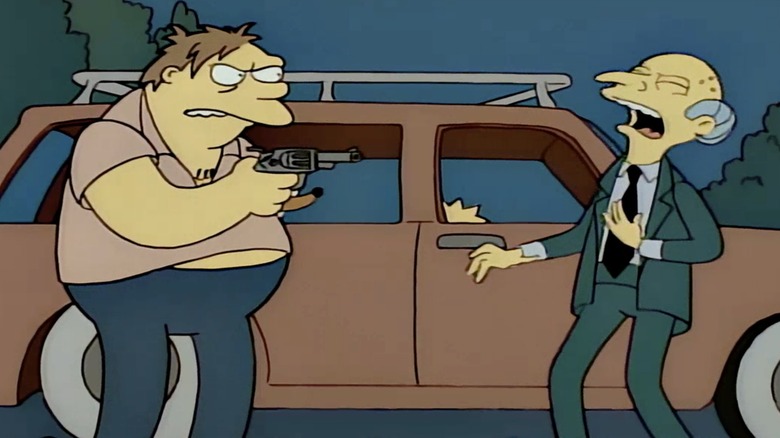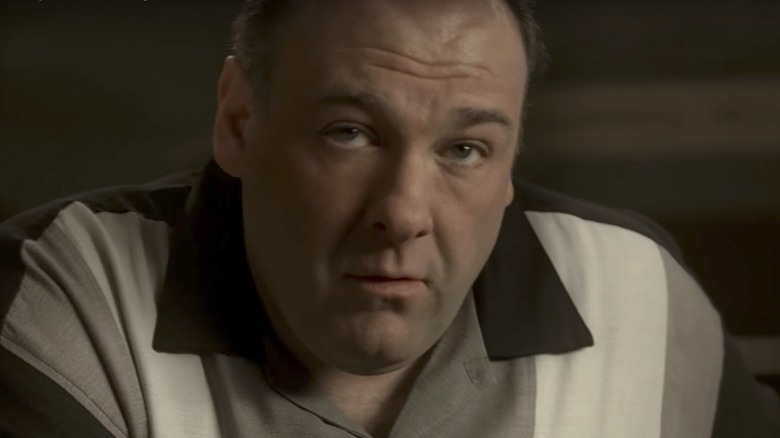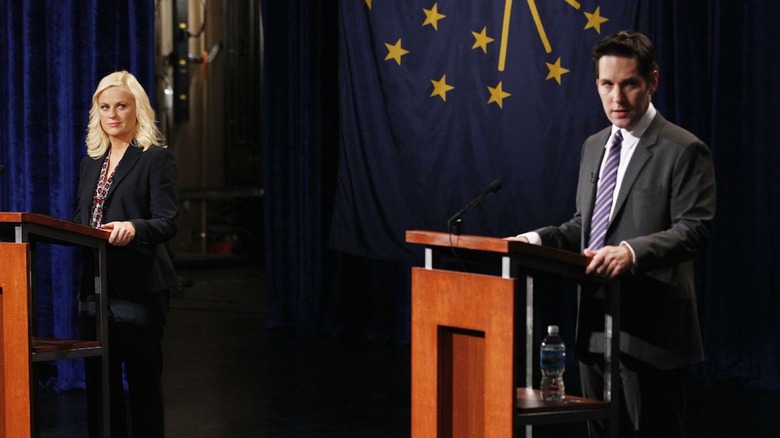TV Shows That Filmed Fake Scenes To Confuse Fans
Popular TV shows can become victims of their own success. Cast and crew make such compelling television that fans just can't wait to find out what happens next on their favorite shows, and will go to any length to get that information—aided by show personnel who leak plot developments, potentially ruining those tightly held twists and reveals. Some productions have tried to thwart these spoilers at great effort and expense by actually scripting and filming scenes they never intend to use. Here's a look at shows that tried to throw off the spoilers with fake footage.
The Walking Dead
The seventh season of The Walking Dead built up to the arrival of Negan (Jeffrey Dean Morgan), leader of the very nasty Saviors. In Robert Kirkman's source comics, Negan almost immediately kills Glenn with Lucille, his barbed-wire wrapped baseball bat. Would the show follow suit, or would another member of Rick's gang, ambushed by the Saviors, meet their doom?
In the mid-season finale, Negan killed...somebody; the show cut to black, and the gut-wrenching sounds of bat meeting brain. Viewers had to wait to learn that Glenn (and Abraham) was indeed at the other end of Lucille. Showrunner Scott Gimple wanted to keep that eventual outcome secret, which was especially difficult because The Walking Dead deals with especially bold and intrusive spoiler-hunters—camera-equipped drones have been spotted flying over the set. In order to preserve the big reveal, the show shot 11 different Lucille-related death scenes: one each for Carl, Rick, Michonne, Eugene, Maggie, Sasha, Daryl, Aaron, Rosita, Abraham, and Glenn.
Game of Thrones
While The Walking Dead crew has to deal with intrusive drones, Game of Thrones has to deal with paparazzi using long-range camera lenses to snap pictures of the show in progress. In the lead up to the show's seventh season in 2017, producers filmed fake scenes to fool those tricky photographers and spoiler-hungry fans. Kit Harington, who stars as Jon Snow, told Jimmy Kimmel Live that the series shot three scenes that weren't part of the show or intended to be used at all. "We put together people in situations where we knew the paparazzi was around so they would take photos and end up on the Internet," Harington explained. "So we'd fake scenes."
Dallas
A massive hit during the 1979–80 TV season, the CBS primetime drama Dallas entranced millions with the story of wicked Texas oil tycoon J.R. Ewing (Larry Hagman) and his family and associates. In the cliffhanger finale, as J.R. got ready for bed one night...someone shot him and left him for dead. It was a shocking TV moment, and over the summer, seemingly all of America debated "Who shot J.R.?"—as pretty much every character on Dallas had a motive. (This doesn't include the thousands of Americans who bought and wore novelty T-shirts which read "I shot J.R.") So as to keep fans guessing in case a cast or crew member leaked the details, multiple resolutions to the cliffhanger were shot. So who really shot J.R.? His mistress and sister-in-law, Kristin Shepard (Mary Crosby).
The Simpsons
Fifteen years after "Who Shot J.R.?," the sixth season of The Simpsons ended with a cliffhanger episode in which Springfield Nuclear Power Plant boss C. Montgomery Burns is shot by an unidentified assailant and collapses onto a sundial, his arms pointed to the "W" and "S." Pretty much everybody in Springfield was a suspect, but in the seventh-season premiere, infant Maggie Simpson was revealed as the shooter.
While there were clues that the baby did it, Simpsons writer David Mirkin told The A.V. Club that he "purposely wanted to construct it so that it made you think that Smithers had done it." Mirkin even tried to anonymously contact entertainment news media organizations such as Entertainment Tonight and leak the fake spoiler that Smithers was the guilty party, but he didn't have any takers. Nevertheless, the show wanted to keep the identity of the Burns shooter secret until it could be revealed on air, and to that end, secrecy-keeping measures were enacted.
As discussed on a Simpsons DVD commentary track, scenes of many characters pulling the trigger were created, including Moe, Apu, Barney, and Santa's Little Helper. To fool leakers further, a complete separate ending was produced in which Smithers actually did shoot Mr. Burns. It was aired as part of the "138th Episode Spectacular" clip show in 1996.
The Sopranos
The Sopranos had one of the most famous—and maddening—final moments in TV history. As gangster Tony Soprano (James Gandolfini) sits in a diner with members of his family and Journey's "Don't Stop Beliievin'" plays on the jukebox, the scene abruptly cuts to black, mid-scene. Many viewers assume that the sudden ending reflects Tony Soprano's fate—he was killed by one of his many enemies. In the decade since The Sopranos wrapped up, creator David Chase has been reluctant to spell out exactly what became of Tony, but in 2016, he told Deadline that he shot a different ending because the production had experienced problems with "people trying to invade and get our scripts."
The scene was shot, but the details were so inconsequential—and destined to be discarded as a ruse—that Chase couldn't even remember all the details. "Tony goes back to the Bad Bing [strip club] and has an argument with Silvio or something. Well, it couldn't have been SIlvio because he was in the hospital," he shrugged. "Well, anyway, it was a fake ending that we shot just to throw people off."
Parks and Recreation
The fourth season of NBC's sweet small-town government comedy concerned the city council election between striving parks department employee Leslie Knope (Amy Poehler) and idiotic candy company scion Bobby Newport (Paul Rudd). The season finale's title "Win, Lose, or Draw" hints at the struggle that the show's writers had with deciding how the election should play out. Would "the right thing" happen and the noble, earnest Leslie win? Would the power of money and local influence propel Bobby to city council? Or would something else happen—like a tie, maybe?
According to showrunner and co-creator Michael Schur at a 2012 PaleyFest panel, the show scripted and shot three different endings. "We want to make sure that the one we are choosing is ... right," said Schur. "And we reserve the right to change our minds, and also partly just to confuse people." In the end, Leslie won the election—but only after a recount that put her ahead by a mere 21 votes.
Lost
John Locke (Terry O'Quinn) met a sad fate on Lost, horrifically strangled to death by Ben Linus (Michael Emerson). But the show played fast and loose with time and space, so Locke was still part of the series even after the revelation that the body in the casket in the funeral parlor was his. Or maybe not: After a major plot in which Locke led a group looking to take down Jacob, his body was shown rolling out of a cargo box. Heroic Leader Locke was actually the shape-shifting Man in Black, and the real Locke was dead. To throw everybody for a loop, or maybe to keep their options open, the Lost crew shot a couple of other scenes, in which the dead man in the coffin isn't Locke, but Sawyer (Josh Holloway) and Desmond (Henry Ian Cusick) instead.
24
Shows kill off main characters all the time these days, but in 2002, it was still quite shocking when somebody on a TV show suddenly and tragically died. The twisty, exciting, pulse-pounding first season of Fox's 24 ended with Teri Bauer (Leslie Hope), pregnant wife of counter-terrorist superman Jack Bauer (Kiefer Sutherland) dying from a gunshot delivered by corrupt agent Nina Myers (Sarah Clarke). It didn't have to be that way: when the series was released on DVD, it included an alternate fake ending in which Teri lived.
Sex and the City
HBO's Sex and the City was an updated, urban take on the romantic comedy, but a romantic comedy nonetheless, and it ended like one: Carrie Bradshaw (Sarah Jessica Parker) wound up with her on-again, off-again guy, Mr. Big (Chris Noth), and returned to New York after a spell in Paris. The day after the finale aired in 2004, Parker told USA Today that three different endings had been shot, with the one true wrap-up kept a secret. The abandoned endings, which Parker called "just silly," involved Carrie returning to New York alone—or with artist boyfriend Aleksandr Petrovsky (Mikhail Baryshnikov).
Newhart
The final episode of Newhart, one of the most popular and acclaimed comedies of the '80s, was highly anticipated. So much so that the show's writers decided to pull off a brilliant fakeout, writing a fake final scene in case it leaked...and then leaking it.
While it was never filmed, the scene was intended to fool fans—it depicted exasperated Stratford Inn owner Dick Loudon (Newhart) dying, going to Heaven, and meeting God, played by George Burns or George C. Scott. After that leaked to the press, the secret of the show's real ending remained a surprise because nobody was looking—and it was a classic, with Newhart waking up in bed on the old The Bob Newhart Show set next to Suzanne Pleshette, who played his wife on that '70s hit series. The twist: All of Newhart had been dream. This final scene, the real one, wasn't scripted—because, after all, a script can't leak if there is no script.


